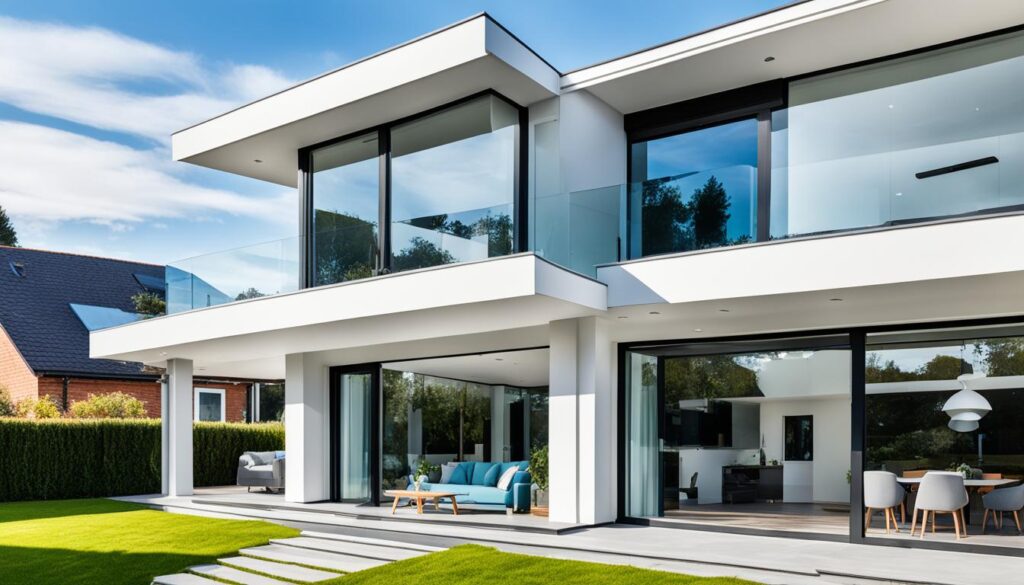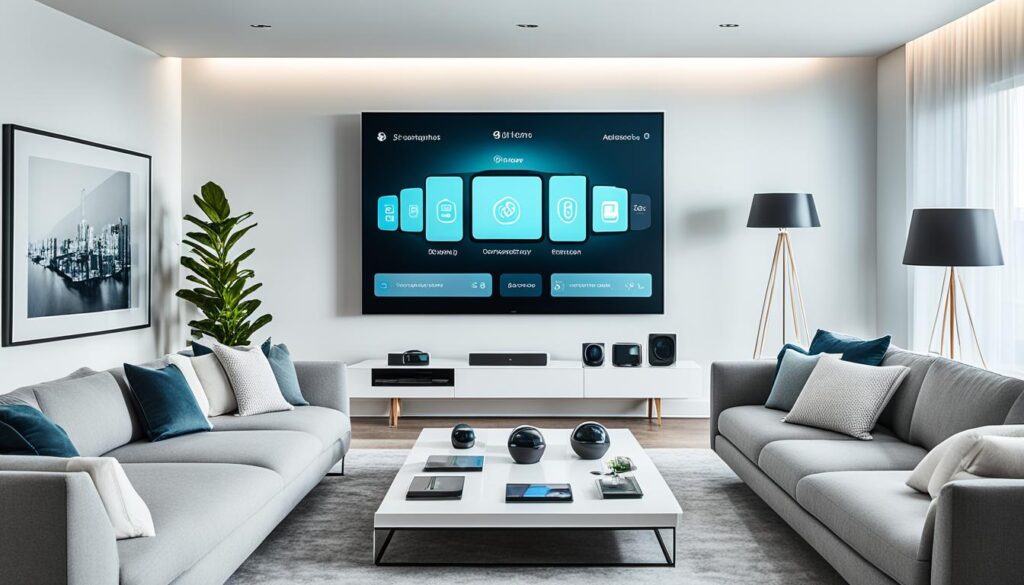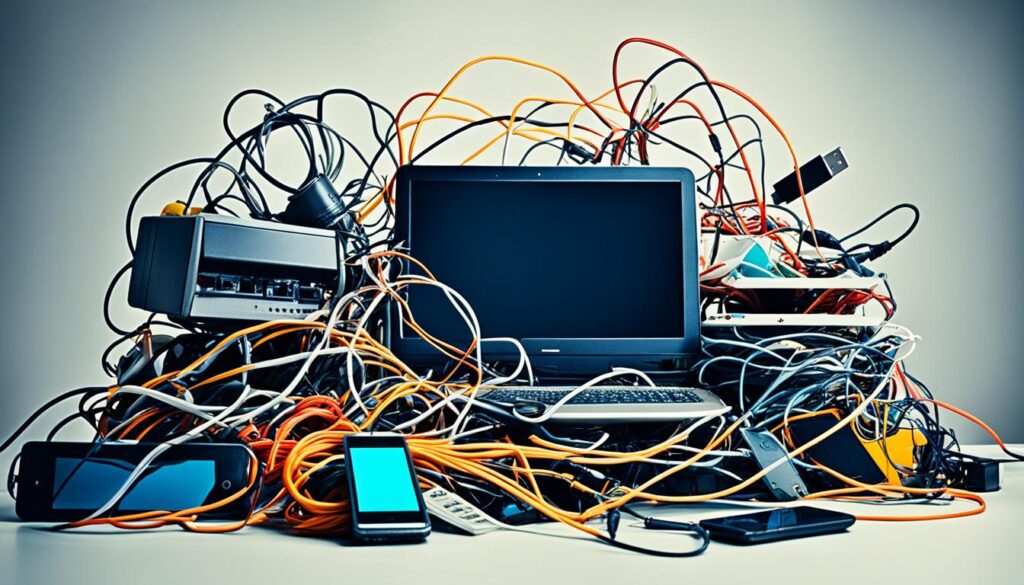In today’s world, our homes are getting smarter. They’re turning into places where everything works together for our benefit. This change is mostly due to connecting all our electronic devices.1 The use of the Internet of Things and the growth in smart home tech, which could hit $313.29 billion by 20271, has really upped our living experience.
Integrating smart devices means making all our tech work as one. We connect our phones, tablets, kitchen devices, and even our cars. This makes it easy to manage everything from one spot, usually an app on our phone. The main aim is to make life more simple, save energy, and improve how we live.1 So, we could adjust our home’s temperature, lights, security, and car options, all using our phone.
Key Takeaways
- Smart device integration enables centralized control and automation of various home systems and appliances.
- Seamless integration of smart devices enhances convenience, energy efficiency, and overall user experience.
- The smart home market is rapidly growing, with the number of connected devices expected to reach 41.6 billion by 2025.
- Voice assistants like Amazon Alexa and Google Assistant are widely used in smart home integrations.
- Investing in a quality router and hub device can improve the stability and performance of smart home systems.
What is Smart Device Integration?
Smart home integration connects different devices, such as phones, appliances, and lights.1 Users can control and automate these devices through a central app or panel. This makes life more convenient, saves energy, and improves how we interact with technology.2
Common Devices for Smart Home Integration
In a smart home, you’ll find appliances, lights, climate control, security systems, and more.1 All these devices work together, letting you manage your home with just your phone or by talking to it. It’s all about making your life simpler and your home safer and more comfortable.
Voice Assistants
Amazon Alexa, Google Assistant, and Apple’s Siri help control your smart home by listening to what you say.1 You can use your voice to do things like turn on lights, adjust the temperature, or lock the front door. This makes managing your home even easier.
Smart Thermostats
Smart thermostats adjust your home’s temperature based on your habits and schedule.1 They learn from you, which means they can keep you comfortable and save energy at the same time.
Smart Lighting
With smart lighting, you can choose the right brightness, color, and timing for your lights.1 It’s not just about looking good; it’s also about saving energy by controlling when and how your lights are used.
Smart Security Devices
Smart security brings cameras, doorbells, and alarms together for better home safety.1 You can watch over your home, get alerts, and manage your security setup from anywhere, making your place more secure.
Smart Plugs
Smart plugs make any outlet smart, letting you control your devices’ power use.1 They fit into your home system, allowing for remote on/off switches, setting schedules, and keeping an eye on energy use.
How to Integrate Smart Home Devices: Platforms & Protocols
Integrating smart home devices together needs different platforms and protocols. The top choices are the smart home systems from3:
- Google Home – Known for its voice control and easy-to-use style3
- Amazon Alexa – Has the most products that work with it and smart displays that are not too expensive3
- Apple HomeKit – Means tight control for folks with iPhones and is very secure3
Alongside these, there are other systems like Home Assistant, Samsung’s SmartThings, and Tuya’s Smart Life3. Each one shines in different ways, suiting varied tastes and the types of devices they work with.
For devices to work together, they must also speak the same language. This is where Bluetooth, Wi-Fi (both 2.4 GHz and 5 GHz), and special tech called Thread, Zigbee, LoRa, and Z-Wave come in3. Now, Wi-Fi 6E, which uses the 6-GHz band, is rolling out. It will give better speeds and performance3.
But, too many smart devices can slow Wi-Fi down, especially in small living spaces. So, it’s wise to get a new router that can handle around 250 devices3. Creating separate networks for your smart devices and guests can keep everything running smoothly and safely too3.
Most smart gadgets are made to work with voice assistants. For example, Google Assistant and Alexa3. If a device shows it works with these systems, or with Apple HomeKit, it means you can easily control it with your voice3.
When you know your options in platforms and protocols, you can really bring your smart home together. This enhances how easy your life is, saves energy, and makes everything better for you314.

Features of Smart Device Integration in Cars
Smart device integration is becoming more common in cars. This tech brings new features that make driving better. These features don’t just add convenience. They also make driving safer and keep us more connected.5
Bluetooth Connectivity
One big feature is Bluetooth. It lets you connect your phone or tablet to your car without wires.5 With Bluetooth, you can take calls, play music, and use apps without looking away from the road or touching your device.
Voice Recognition
Cars with smart integration also offer voice control.5 You can say simple commands to do things like adjust the temperature, find a radio station, or set your GPS. This makes it easier to use your car’s features without getting distracted.
Smartphone Mirroring
Smartphone mirroring is a cool feature.5 It lets your smartphone work with your car’s screen. This way, you can see and use your apps, maps, and more on a big screen. Apple CarPlay and Android Auto are two popular mirroring technologies.
| Feature | Description |
|---|---|
| Bluetooth Connectivity | Enables hands-free calling, music streaming, and mobile app access5 |
| Voice Recognition | Allows voice-controlled adjustment of vehicle functions and settings5 |
| Smartphone Mirroring | Integrates your smartphone’s apps, maps, and content onto the car’s display5 |
Best Security Camera for Smart Home Integration
Security cameras are key for smart homes, boosting monitoring and safety. The Reolink Go PT Ultra is a top pick in this field.6
Reolink Go PT Ultra
The Reolink Go PT Ultra offers 4K resolution and smart features.6 It’s wireless and uses 4G LTE, meaning it doesn’t need a power outlet or Wi-Fi. You can place it anywhere in your home.6 This feature is perfect for outdoor security or places without easy access.
It stands out with its sharp 4K video and 360-degree view.6 You can see everything, day or night, thanks to its night vision. This ensures your home is always visible, even in the dark.
The camera works well with Amazon Alexa and Google Assistant for voice control.6 This makes managing your camera simple. You can check live feeds, watch recordings, and get alerts on your phone or through your smart speaker.
It’s strong, weatherproof, and packed with security features. The Reolink Go PT Ultra is great for anyone wanting to upgrade their home’s safety.6 Whether you’re watching over your property or your family, it offers both peace of mind and ease of use.

Smart Home Integration
Our homes have advanced into smart spaces powered by the latest tech. They offer us convenience and efficiency like never before. So, we can control almost everything in our homes easily, either by touching a screen or just by using our voice.7
With Control4, your home can be smarter, truly fitting your needs, no matter its size or your budget.7 Control4 Smart Home OS 3 puts control of your devices in your hands in a fun and simple way.7 You can use touchscreens, keypads, voices, or apps to make your home uniquely yours.7
Using Control4’s Smart Lighting, you can adjust the lights in your whole house, start music playlists, get alerts when doors are open, and ensure light is ready when you arrive.7 Chime, a part of Control4, lets you talk to visitors, turn lights off or on, unlock doors, and even oversee deliveries from afar.7 Through Control4 Connect, monitoring your house from anywhere is easy. You can get alerts, check cameras and lights, and use voice commands.7
There’s a growing worry about smart home security. A Parks Associates report says 55% of people are concerned about their smart devices’ safety.8 Another concern is personal data security, with 72% expressing worry.8 Matter, the new smart home standard, aims to ease these concerns by making devices from different brands work together better. Major players like Amazon and Apple are on board.8
Control4 Certified Showrooms offer great deals and prizes for lucky customers and #C4Yourself events attendees.7 Every year, over 1 million burglaries occur in the US alone, yet 75% of US homes lack security systems.9 SmartHouse Integration has won numerous awards and is highly regarded by industry leaders.9
In the past few years, SmartHouse Integration was honored with the industry’s prestigious Mark of Excellence awards for its home and tech innovation, along with other outstanding projects.9 Their excellent work has continued to be recognized by experts in the field for many years.9
The Benefits of Seamless Integration
Seamless integration in smart homes brings many advantages.10 It makes our lives better in several ways.
Enhanced Convenience
Integrating smart home systems lifts convenience levels.10 More than 90% of users find their experience smoother with integrated software.10 Also, the function and feel of smart devices get better by 70% with seamless setup.10
Improved Energy Efficiency
Integrating systems also boosts energy efficiency.10 It saves time on repetitive tasks by 50% when integrated.10 Plus, it cuts the chance of hacking by 45% in digital systems.10 AI in smart homes can manage energy better, boosting efficiency.11
Centralized Control
Integration gives smart home owners centralized control.10 Over 80% of companies see better efficiency thanks to integrated operations.10 And 75% of users note a more connected digital life with integration.10
This setup lets users manage different home systems more easily.11 By using seamless integration, you can enjoy a life with more convenience, save energy, and control your home from one place.1011
Creating a Seamless Smart Home Experience
A smart home needs a central control hub to join all its devices and systems.12 This hub is like the brain of your smart home. It lets you control things like the temperature, lights, and check cameras from one spot.12
Smart Hubs and Control Centers
Companies like Philips Hue offer smart hubs for your home.3 These hubs help keep your devices stable and responsive.3 They use special tech like Thread, Zigbee, LoRa, and Z-Wave to make sure all devices can talk to each other easily.3
Voice Control and Automation
Voice control is now a big part of making your home smarter.12 With Google Home, Amazon Alexa, or Apple HomeKit, you just need to use your voice.3 This makes it easy to adjust the lights, security, and more without lifting a finger.12
Cross-Platform Compatibility
When you set up a smart home, think about compatibility.3 There are three main systems to pick from: Google Home, Amazon Alexa, and Apple HomeKit. Each works better with certain devices and features.3 Pick one that goes with what you already have to make everything work together smoothly.3
By using smart hubs, voice control, and choosing the right systems, you’ll make a home that fits your needs.12 This helps your home run better, saves energy, and makes life more comfortable. The trick is to choose devices that all work well together.12

Smart Home Electronics Integration with ByteSize Store
To start turning your home into a smart one, you first need top-quality products. These products should be reliable and flexible. ByteSize Store has all you need, from smart home gadgets to devices. They bring smartness and advanced features into your home easily.
Smart Lighting Solutions
ByteSize Store offers a range of smart lights to make your home look good and save energy. You can choose from voice-controlled lights to lights that change color. These lights help set the perfect mood and lower your bills.13 Plus, smarter lights mean less work for you, and you save time. Knowing how much energy you use helps tweak your lighting to be just right.13
Home Security Systems
Keep your home safe with ByteSize Store’s smart security systems. You can set up cameras, sensors, and special locks. They let you watch over your home when you’re not there and keep you updated. Finding leaks early can cut down on water waste and the power needed to fix damage.13 Regular security checks help spot any big problems early, saving you from higher maintenance costs or having to replace items.13
Entertainment and Home Theater
Make your space the go-to spot for entertainment with ByteSize Store’s smart gadgets. You can connect your TV, sounds, and streaming. This setup brings the theater experience right to your couch. Smart home setups can eventually save you a lot on your energy bills.13 Getting alerts on your energy use can help keep your system in check. This way, you tweak as needed, keeping everything running smoothly.13
Overcoming Challenges in Smart Device Integration
The smart home revolution is picking up speed. Yet, challenges remain for a smooth device integration. These issues are connected to
interoperability and standards, privacy and security concerns, and the ease of setup and configuration
Interoperability and Standards
The lack of common standards is a major hurdle in smart home tech. This means devices often can’t talk to each other.14 There are attempts to create these standards. But, they are scattered. Various groups try, but a shared standard is missing. Manufacturers add their own systems and services, making cross-brand use a tangled experience.14 This situation makes different brand devices struggle to work together.
Privacy and Security Concerns
Making sure your smart home is safe and private is a big challenge. The lack of security standards and checks means devices could be at risk. Threats like hacking and malware are real.14 With more devices joining your network, the risk grows. So, strong security measures are crucial.
Ease of Setup and Configuration
Getting smart home devices to work together is not easy. There are many communication styles, such as Wi-Fi or Bluetooth, suited for different needs.14 This variety makes setting up a challenge, especially for those not tech-savvy. Also, data from devices might not always match up. This can lead to more compatibility issues.14 Finding ways to make setup easier and smoother is key to a great smart home experience.

Beating the challenges of smart home tech requires teamwork and strong standards. Designing with the user in mind is also crucial. By tackling these issues, smart homes can truly elevate living, offering more convenience, saving energy, and keeping families safer.
Conclusion
Smart home tech has changed how we use our homes, making everything easy and smart. It lets us control everything together, from lights to locks, with ease. All our devices and systems connect perfectly. This makes our homes work smarter.15
IoT devices are key in making homes smart and connected. They let us keep an eye on and adjust things like lights and security from anywhere. Using just our phones or even our voices, we can make our homes do what we want.
Plus, with voice assistants like Alexa and Siri, controlling our homes is hands-free and easy.15
The future of these smart homes is only getting brighter. We’ll see more ways to save energy, stay safe, have fun, and keep healthy.15 Having a connected home brings so many benefits. As tech keeps getting better, our homes will too. This means a better life, less harm to the Earth, and a more connected place to live.
Choosing these smart solutions is good for us and our planet. It makes our homes work better for us.15
FAQ
What is smart device integration?
Smart device integration is about linking and syncing different electronics. These include smartphones, tablets, home gadgets, and car systems. They work together smoothly using a central app or panel.
What are the common devices used in smart home integration?
Devices like smart home assistants, thermostats, lights, security gadgets, and plugs are typical.
What are the platforms and protocols used for smart home integration?
Amazon Alexa, Google Assistant, and Apple HomeKit are popular. So are Samsung SmartThings, Zigbee, and Z-Wave.
What are the features of smart device integration in cars?
In cars, integration means Bluetooth, voice commands, and linking your phone. These features make driving better.
What is the best security camera for smart home integration?
The top pick for smart homes is the Reolink Go PT Ultra camera. It has 4K video, wireless use, and LTE support.
What are the benefits of seamless smart home integration?
Seamless integration makes life easier, saves energy, and lets you control everything from one place.
What are the challenges in smart device integration?
It’s hard when devices don’t work well together or if privacy is at risk. Setting up can also be tricky.
Source Links
- https://reolink.com/blog/smart-device-integration/
- https://www.ultra-vision.net/smart-home-integration/
- https://www.wired.com/story/how-to-set-up-smart-home/
- https://evvr.io/blogs/newsroom-2/how-to-integrate-all-smart-home-devices-for-smart-home-integrator
- https://ambiq.com/blog/integrated-smart-devices-for-automobiles/
- https://www.techradar.com/news/best-home-security-camera
- https://www.control4.com/
- https://www.techtarget.com/iotagenda/definition/smart-home-or-building
- https://www.smarthouseintegration.com/
- https://www.lenovo.com/us/en/glossary/seamless-integration/
- https://inoxoft.com/blog/how-to-use-ai-for-smart-home-technology/
- https://medium.com/@leslie.holmes.writing/home-electronics-integration-creating-seamless-smart-homes-79e95ff8f57d
- https://tempcube.io/blogs/temperature-humidity/byte-size-savings-how-smart-humidity-controls-and-automation-can-reduce-utility-costs
- https://www.iot-now.com/2024/06/04/144693-interoperability-issues-the-hidden-challenges-of-iot-integration/
- https://insightss.co/blogs/the-rise-of-the-smart-home-how-technology-is-changing-the-way-we-live/
